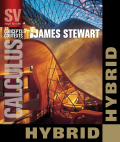
Reflecting Cengage Learning's commitment to offering flexible teaching solutions and value for students and instructors, this new hybrid edition features the instructional presentation found in the printed text while delivering end-of-section exercises online in Enhanced WebAssign. The result -a briefer printed text that engages students online! Stewart's CALCULUS: CONCEPTS AND CONTEXTS, FOURTH EDITION offers a streamlined approach to teaching calculus, focusing on major concepts and supporting them with precise definitions, patient explanations, and carefully graded problems. CALCULUS: CONCEPTS AND CONTEXTS is highly regarded because this text offers a balance of theory and conceptual work to satisfy more progressive programs as well as those who are more comfortable teaching in a more traditional fashion. This title is just one component in a comprehensive calculus course program that carefully integrates and coordinates print, media, and technology products for successful teaching and learning. INDICE: Preface. To the Student. A Preview of Calculus. 1. FUNCTIONS AND MODELS. Four Ways to Represent a Function. Mathematical Models: A Catalog of Essential Functions. New Functions from Old Functions. Graphing Calculators and Computers. Exponential Functions. Inverse Functions and Logarithms. ParametricCurves. Laboratory Project: Running Circles around Circles. Review. Principles of Problem Solving. 2. LIMITS AND DERIVATIVES. The Tangent and Velocity Problems. The Limit of a Function. Calculating Limits Using the Limit Laws. Continuity. Limits Involving Infinity. Derivatives and Rates of Change. Writing Project: Early Methods for Finding Tangents. The Derivative as a Function. What Does f' ¿ Say about f ? Review. Focus on Problem Solving. 3. DIFFERENTIATION RULES. Derivatives of Polynomials and Exponential Functions. Applied Project: Building a Better Roller Coaster. The Product and Quotient Rules. Derivatives of Trigonometric Functions. The Chain Rule. Laboratory Project: Bézier Curves. Applied Project: Where Should a Pilot Start Descent? Implicit Differentiation. Inverse Trigonometric Functions and their Derivatives. Derivatives of Logarithmic Functions. Discovery Project: Hyperbolic Functions. Rates of Change in the Natural and Social Sciences. Linear Approximations and Differentials. Laboratory Project: Taylor Polynomials. Review. Focus on Problem Solving. 4. APPLICATIONS OF DIFFERENTIATION. Related Rates. Maximum and Minimum Values. Applied Project: The Calculus of Rainbows. Derivatives and the Shapes of Curves. Graphingwith Calculus and Calculators. Indeterminate Forms and l'Hospital's Rule. Writing Project: The Origins of l'Hospital's Rule. Optimization Problems. AppliedProject: The Shape of a Can. Newton's Method. Antiderivatives. Review. Focus on Problem Solving. 5. INTEGRALS. Areas and Distances. The Definite Integral. Evaluating Definite Integrals. Discovery Project: Area Functions. The Fundamental Theorem of Calculus. Writing Project: Newton, Leibniz, and the Invention of Calculus. The Substitution Rule. Integration by Parts. Additional Techniquesof Integration. Integration Using Tables and Computer Algebra Systems. Discovery Project: Patterns in Integrals. Approximate Integration. Improper Integrals. Review. Focus on Problem Solving. 6. APPLICATIONS OF INTEGRATION. More about Areas. Volumes. Discovery Project: Rotating on a Slant. Volumes by Cylindrical Shells. Arc Length. Discovery Project: Arc Length Contest. Average Value ofa Function. Applied Project: Where To Sit at the Movies. Applications to Physics and Engineering. Discovery Project: Complementary Coffee Cups. Applications to Economics and Biology. Probability. Review. Focus on Problem Solving. 7. DIFFERENTIAL EQUATIONS. Modeling with Differential Equations. Direction Fieldsand Euler's Method. Separable Equations. Applied Project: How Fast Does a Tank Drain? Applied Project: Which Is Faster, Going Up or Coming Down? Exponential Growth and Decay. Applied Project: Calculus and Baseball. The Logistic Equation. Predator-Prey Systems. Review. Focus on Problem Solving. 8. INFINTE SEQUENCES AND SERIES. Sequences. Laboratory Project: Logistic Sequences. Series. The Integral and Comparison Tests; Estimating Sums. Other Convergence Tests. Power Series. Representations of Functions as Power Series. Taylor and Maclaurin Series. Laboratory Project: An Elusive Limit. Writing Project: How Newton Discovered the Binomial Series. Applications of Taylor Polynomials. Applied Project: Radiation from the Stars. Review. Focus on Problem Solving. APPENDIXES. A. Intervals, Inequalities, and Absolute Values. B. Coordinate Geometry. C. Trigonometry. D. Precise Definitions of Limits. E. A Few Proofs. F. Sigma Notation.G. Integration of Rational Functions by Partial Fractions. H. Polar Coordinates. I. Complex Numbers. J. Answers to Odd-Numbered Exercises.
- ISBN: 978-1-133-62715-9
- Editorial: Brooks/Cole
- Encuadernacion: Rústica
- Páginas: 590
- Fecha Publicación: 31/01/2012
- Nº Volúmenes: 1
- Idioma: Inglés
